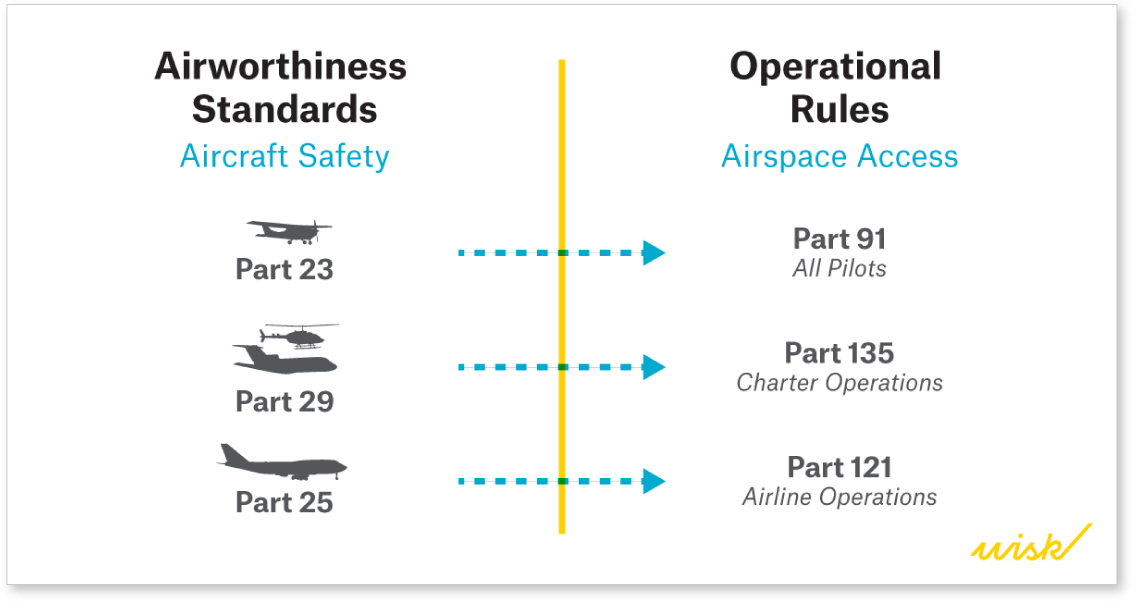By Phil Coyle, Wisk Flight Test Engineer
In July, the Federal Aviation Administration (FAA) published V1.0 of its Concept of Operations (CONOPS) for Urban Air Mobility (UAM). The release represents a significant step for the UAM industry in that, for the first time, the FAA has formally articulated a potential path forward for the integration of UAM aircraft into the National Airspace System.
The concept of Urban Air Mobility (UAM) refers to the suite of services that can be offered by highly automated, passenger or cargo-carrying air vehicles in and around urban areas. UAM is a subset of Advanced Air Mobility (AAM), a concept recently developed by the National Aeronautics and Space Administration (NASA), the FAA, and the aviation industry. AAM encompasses the broad set of operations achievable by highly automated or unmanned aircraft in all airspace environments, while UAM focuses specifically on urban and suburban areas. Wisk’s vision of developing an air taxi system using an aircraft like Cora fits directly within the construct of UAM.
Being “Version 1.0”, the CONOP is expected to mature through industry comment and review processes, and Wisk looks forward to being part of that conversation. For now, the significance is that we have the FAA more actively contributing to airspace integration conversation for UAM.
Let’s take a closer look at what is actually meant by the term “airspace integration” and why airspace integration is a challenge for UAM aircraft in the first place.
Regulatory Background
Understanding airspace integration first requires knowledge of the two main mechanisms by which a regulator such as the FAA maintains safety:
- Aircraft Certification: Before a newly designed aircraft can be sold commercially, it must go through a rigorous review and testing process by which the manufacturer demonstrates the aircraft meets established airworthiness standards. Certification is the process by which the regulator verifies that an aircraft is generally safe to fly.
- Operational Rules: While operating an aircraft, the pilot (and potentially the airline or operator that employs the pilot) must comply with a set of rules that govern the manner in which aircraft can be utilized. Operational rules are the methods by which the regulator ensures aircraft are operated in a safe manner.
Simply put, “airspace integration” is the ability of a particular aircraft or operator to legally and safely access and operate within the airspace. It is directly linked to the operational rules construct described above, as operational rules define how aircraft must be operated such that they can integrate into the National Airspace System.
Historically, aircraft certification and operational rules have been treated independently from each other. They are overseen by separate departments within the FAA, and the method for demonstrating compliance to each differs dramatically. However, they are intrinsically linked in that compliance with both airworthiness standards and operational rules is required for an aircraft to be commercially viable. An aircraft may be deemed safe and certified by a regulator, but if that aircraft is not operated in accordance with the relevant set of operating rules, or if appropriate operating rules don’t exist, it cannot legally access the National Airspace System and thus has no practical use.
Figure 1 depicts a simplified illustration of the established FAA rule sets (i.e., the “Parts” of the Federal Aviation Rules) that pertain to airworthiness standards and operational rules.

As depicted in the Figure, the established FAA rule sets are written to handle the vast majority of existing types of aircraft (e.g., general aviation, helicopters, transport category, etc.) and their respective operations (e.g., private operations, commercial charter operations, scheduled airline operations, etc.). Furthermore, there is generally a mapping between a set of airworthiness standards for a given type of aircraft and the set of operational rules for how that aircraft may be operated.
For example, a typical general aviation aircraft such as a Cessna 172 is certified against Part 23. A private pilot operating that aircraft must adhere to the operational rules established in Part 91, which is the “General Operating and Flight Rules” set that applies to all aircraft operations. Similarly, a transport category aircraft such as a Boeing 737 is certified to Part 25. In addition to the pilots needing to adhere to Part 91, the airline operating the aircraft is subject to Part 121 operating rules, which includes additional requirements such as dispatch requirements and crew duty time limitations.
Fundamentally, these regulations are designed to keep the public safe—and they do so successfully. For years, air travel has consistently been one of the safest modes of transportation, in large part due to a consistent focus by industry and regulators on risk mitigation and failure reduction. As UAM seeks to become a larger player in this industry, companies such as Wisk must hold safety paramount: the introduction of UAM cannot jeopardize the integrity and safety of the existing aviation ecosystem.
The Opportunity
At scale, the UAM concept calls for hundreds of aircraft operating thousands of flights per day in a high-density, urban airspace environment. This operational tempo, coupled with the relatively low altitudes and short durations envisioned for these flights, means that UAM aircraft will operate quite differently than aircraft do today. Thus, the key challenge facing companies like Wisk is that there is no existing set of operational rules UAM aircraft can directly comply with in order to gain access to the airspace.
At Wisk, we think of this problem not as a challenge, but as an opportunity! The current airspace structure, air traffic management procedures, and air traffic control system were not originally designed to support UAM operations at scale. But by working together to decide how UAM can and should be integrated into the airspace system, the aviation community has the opportunity to re-imagine what tomorrow’s airspace system should look like.
There’s no shortage of exciting work that lies ahead: performing UAM operations safely and smoothly requires developing new supporting infrastructure that will redefine our view of urban centers; it calls for writing and certifying highly automated algorithms that push the current bounds of artificial intelligence; and it implies engineering new, complex propulsion and energy systems that will spark new areas of research in science and technology…and that’s just to name a few!
It’s true that capitalizing on these opportunities will be difficult. However, if the aviation community is successful in doing so, it means that we will have revolutionized the aviation ecosystem in a way that fundamentally changes the human experience. Imagine a world where flight touches our lives on a daily basis—be it through how we commute, how we transport goods, or how our first responders perform life-saving services. The opportunities abound!
For us at Wisk, that’s a future worth getting excited about.
The Path Forward
Wisk genuinely believes aircraft like Cora have the potential to safely revolutionize transportation and change the way humans think about aviation, and we’re serious about making UAM a reality. However, we also understand that UAM needs to be accommodated in a way that doesn’t jeopardize the integrity and safety of the existing air traffic system.
Safely solving the challenges associated with airspace integration begins with an open dialogue between relevant stakeholders to discuss the issues, propose ideas, and work towards a consensus solution. In releasing the first version of its UAM CONOPS document, the FAA has provided the starting point for an industry-wide dialogue for UAM airspace integration, and it is also poised to take a leadership role in guiding the conversation. Wisk is excited to see the FAA engage on this level, and looks forward to contributing to the development of UAM going forward.




